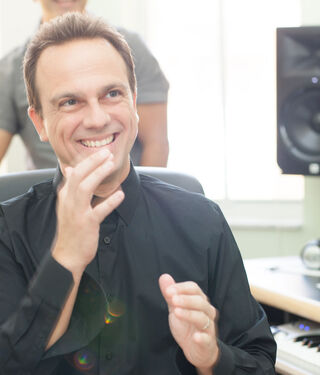Media
Film Music and the Suspension of Disbelief
A Q&A with film composer Carlos Rafael Rivera.
Posted December 9, 2020

I have long been fascinated with music’s ability to take viewers on an emotional journey when watching a movie or TV show. I mean, how different is this scene in Jurassic Park without the soaring melodies of John Williams? So when I realized my colleague, composer Carlos Rafael Rivera, was the musical brains behind the latest “it” TV show The Queen’s Gambit, it seemed the perfect opportunity to hear his perspective and thoughts about film and TV music.
Kimberly Sena Moore: What do you see as the role of music in a film/TV show?
Carlos Rafael Rivera: Thanks for the interview! Music’s primary role is to serve the story. It is one of many elements that aid in the suspension of our disbelief as an audience. Everything we are experiencing is an illusion, from the sets not being actual locations, to the actors not being the people they are playing, costumes, sound, all of these elements come together — along with music — to help us experience something that is not real, yet feels immersive.
KSM: Music is this rather complex phenomenon with multiple elements — harmony, timbre, rhythm, texture, melody, and more. Is there one particular musical element you relish using in your scores? If so, why?
CRR: I am certainly a fan of good melodic writing, but find there are many stories that may not require it to be best told. The use of color as tension can be as effective as melody. As an example, some of the more haptic composers, such as Cliff Martinez, Atticus Ross and Trent Reznor, and to a certain degree Jonny Greenwood, are making music that attracts at least as much for its sound/color, over the melodic content. Their work shines in stories such as Drive, Birdbox, or Phantom Thread. Being open to any musical means to support the story the director wants to convey feels best for me.
KSM: What was most exciting to you about this particular project, The Queen’s Gambit?
CRR: Getting to write music for a character as complex and complicated as Beth Harmon, who was masterfully portrayed by Anya Taylor-Joy. Through this opportunity, the main challenge was to avoid writing a “Beth Theme,” but rather Themes for aspects of Beth’s character: Addiction, Genius, Mischief, Growth, etc. By resorting to different themes, I found myself applying them throughout the seven episodes, whenever one of these aspects were guiding her character in a scene, creating a more holistic representation of Beth.
KSM: What might surprise viewers about the music in The Queen’s Gambit?
CRR: Ideally, I wanted to represent Beth’s life in the orphanage with the piano as the main color, and increase the palate of instruments throughout each episode toward the full orchestra by the time she has her big match with Borgov. Although her reality in the beginning was just the piano, what she visualized in her head as she played on the ceiling was always orchestral — just as when you were a child, and had big dreams — in her mind they were fully formed. By the time Beth arrives in the USSR in the final episode, she is fully developed, and so the orchestral music matches the reality she always envisioned, leaving the piano — along with her childhood — behind.
KSM: If there was one thing you wished audiences would know or pay attention to about the musical score when watching a film/TV show, what would that be?
CRR: It depends, as music’s pragmatic function is to help in scene transitions, character/location establishment, as well as montages. When it is doing its job, the audience should NOT notice it. It is not often that a musical cue rises above its pragmatic role. Those are unicorns, and are what make up some of our favorite film scores. However, I don’t feel it should be the aim of a composer to write music that stands out, but rather serve the story. As an example, one of my favorite cues is from Ennio Morricone’s final scene of Cinema Paradiso. The reason it moves me, when I think about it, is not the music alone, but how it works along with the story. It is the complete experience (visuals/editing/acting/sound/music) that locks the soundtracks in our hearts.
Carlos Rafael Rivera is an Emmy Award-winning composer, whose career has spanned several genres of the music industry. He mentored with the incomparable Randy Newman while studying at USC’s Thornton School of Music. His work for film and TV includes scores for Netflix’ Godless, Universal Pictures’ A Walk Among the Tombstones, and the universally-acclaimed Netflix Mini-Series The Queen’s Gambit. Carlos is Assistant Professor and Director of the Media Writing and Production Program at the University of Miami's Frost School of Music. Follow him on social media @composer313 and as @carlosrafaelrivera313 on YouTube.


